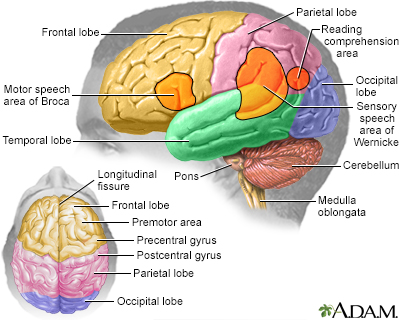EEG
An electroencephalogram (EEG) is a test to measure the electrical activity of the brain.
How the Test is Performed
The test is done by an EEG technologist in your health care provider's office or at a hospital or lab.
The test is done in the following way:
- You lie on your back on a bed or in a reclining chair.
- Flat metal disks called electrodes are placed on many spots on your scalp. The disks are held in place with a sticky paste. The electrodes are connected by wires to a recording machine. The machine changes the electrical signals into patterns that can be seen on a monitor or drawn on paper. These patterns look like wavy lines.
- You need to lie still during the test with your eyes closed. This is because movement can change the results. You may be asked to do certain things during the test, such as breathe fast and deeply for several minutes or look at a bright flashing light.
- You may be asked to sleep during the test.
If your provider needs to monitor your brain activity for a longer period, an ambulatory EEG will be ordered. In addition to the electrodes, you will wear or carry a special recorder for up to 3 days. You will be able to go about your normal routine as the EEG is being recorded. Or, your provider may ask you to stay overnight in a special EEG monitoring unit where your brain activity will be monitored continuously. Video recording may be done at the same time to see what you are doing during the various electrical signals.
How to Prepare for the Test
Wash your hair the night before the test. Do not use conditioner, oils, sprays, or gel on your hair. If you have a hair weave, ask your provider for special instructions.
Your provider may want you to stop taking certain medicines before the test. Do not change or stop taking any medicines without first talking to your provider. Bring a list of your medicines with you.
Avoid all food and drinks containing caffeine for 8 hours before the test.
You may need to sleep during the test. If so, you may be asked to reduce your sleep time the night before. If you are asked to sleep as little as possible before the test, do not eat or drink any caffeine, energy drinks, or other products that help you stay awake.
Follow any other specific instructions you are given.
How the Test will Feel
The electrodes may feel sticky and strange on your scalp, but should not cause any other discomfort. You should not feel any discomfort during the test.
Why the Test is Performed
Brain cells communicate with each other by producing tiny electrical signals, called impulses. An EEG measures this activity. It can be used to diagnose or monitor the following health conditions:
- Seizures and epilepsy
Seizures
A seizure is the physical changes in behavior that occurs during an episode of specific types of abnormal electrical activity in the brain. The term ...
 ImageRead Article Now Book Mark Article
ImageRead Article Now Book Mark ArticleEpilepsy
Epilepsy is a brain disorder in which a person has repeated seizures over time. Seizures are episodes of uncontrolled and abnormal electrical activi...
 ImageRead Article Now Book Mark Article
ImageRead Article Now Book Mark Article - Brain diseases, such rapidly progressing dementia or certain infections (encephalitis)
- Coma
- Fainting spells or periods of memory loss that cannot be explained otherwise
- Head injuries
Head injuries
A head injury is any trauma to the scalp, skull, or brain. Head injury can be either closed or open (penetrating). A closed head injury means you rec...
 ImageRead Article Now Book Mark Article
ImageRead Article Now Book Mark Article - Behavioral changes
- Tumors or other lesions
- Critical illness in newborn babies
EEG is also used to:
- Evaluate problems with sleep (sleep disorders)
Sleep disorders
Sleep disorders are problems with sleeping. These include trouble falling or staying asleep, falling asleep at the wrong times, too much sleep, and ...
 ImageRead Article Now Book Mark Article
ImageRead Article Now Book Mark Article - Monitor the brain during brain surgery
An EEG may be done to show that the brain has no activity, in the case of someone who is in a deep coma. It can be helpful when trying to decide if a person is brain dead.
An EEG cannot be used to measure intelligence.
Normal Results
Brain electrical activity has a certain number of waves per second (frequencies) that are normal for different levels of alertness. For example, brain waves are faster when you are awake and slower in certain stages of sleep.
There are also normal patterns to these waves.
Note: A normal EEG does not mean that a seizure did not occur.
What Abnormal Results Mean
Abnormal results on an EEG test may be due to:
- Abnormal bleeding (hemorrhage) in the brain
- An abnormal structure in the brain (such as a brain tumor)
- Tissue death due to a blockage in blood flow (cerebral infarction, also called a stroke)
Stroke
A stroke occurs when blood flow to a part of the brain stops. A stroke is sometimes called a "brain attack. " If blood flow is cut off for longer th...
 ImageRead Article Now Book Mark Article
ImageRead Article Now Book Mark Article - Medicines
- Illicit drug or alcohol use
- Head injury
- Migraines (in some cases)
Migraines
A migraine is a type of headache. It may occur with symptoms such as nausea, vomiting, or sensitivity to light and sound. In most people, a throbbi...
 ImageRead Article Now Book Mark Article
ImageRead Article Now Book Mark Article - Seizure disorder (such as epilepsy)
Epilepsy
Epilepsy is a brain disorder in which a person has repeated seizures over time. Seizures are episodes of uncontrolled and abnormal electrical activi...
 ImageRead Article Now Book Mark Article
ImageRead Article Now Book Mark Article - Sleep disorder (such as narcolepsy)
Narcolepsy
Narcolepsy is a nervous system problem that causes extreme sleepiness and attacks of daytime sleep.
 ImageRead Article Now Book Mark Article
ImageRead Article Now Book Mark Article - Brain infection
- Kidney or liver disease (metabolic disease)
Risks
An EEG test is very safe. The flashing lights or fast breathing (hyperventilation) required during the test may trigger seizures in those with seizure disorders. The provider performing the EEG is trained to take care of you if this happens.
Hyperventilation
Hyperventilation is rapid and deep breathing. It is also called overbreathing, and it may leave you feeling breathless.

Reviewed By
Luc Jasmin, MD, Ph.D., FRCS (C), FACS, Department of Neuroscience, Guam Regional Medical City, Guam; Senior Advisor at Elevance Health, Department of Surgery, Johnson City Medical Center, TN; Senior advisor at Elevance Health Department of Maxillofacial Surgery at UCSF, San Francisco, CA. Review provided by VeriMed Healthcare Network. Also reviewed by David C. Dugdale, MD, Medical Director, Brenda Conaway, Editorial Director, and the A.D.A.M. Editorial team.
Deluca GC, Griggs RC, Johnston C. Approach to the patient with neurologic disease. In: Goldman L, Cooney KA, eds. Goldman-Cecil Medicine. 27th ed. Philadelphia, PA: Elsevier; 2024:chap 366.
Dilena R, Raviglione F, Cantalupo G, et al. Consensus protocol for EEG and amplitude-integrated EEG assessment and monitoring in neonates. Clin Neurophysiol. 2021;132(4):886-903. PMID: 33684728 pubmed.ncbi.nlm.nih.gov/33684728/.
Hahn CD, Emerson RG. Electroencephalography and evoked potentials. In: Jankovic J, Mazziotta JC, Pomeroy SL, Newman NJ, eds. Bradley and Daroff's Neurology in Clinical Practice. 8th ed. Philadelphia, PA: Elsevier; 2022:chap 35.
Hunt DPJ, Connor MD. Neurology.In: Penman ID, Ralston SH, Strachan MWJ, Hobson RP, eds. Davidson's Principles and Practice of Medicine. 24th ed. Philadelphia, PA: Elsevier; 2023:chap 28.
Mikhaeil-Demo Y, Gonzalez Otarula KA, Bachman EM, Schuele SU. Indications and yield of ambulatory EEG recordings. Epileptic Disord. 2021;23(1):94-103.PMID: 33622660 pubmed.ncbi.nlm.nih.gov/33622660/.

 All rights reserved.
All rights reserved.